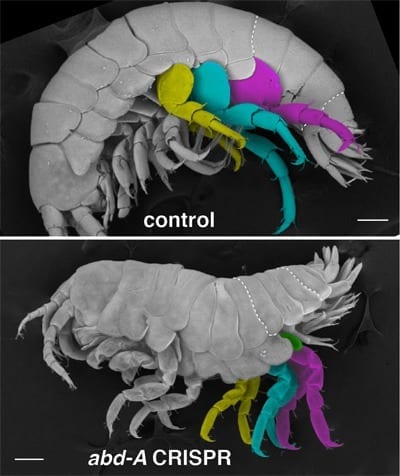
The simplicity of CRISPR-Cas9 gene editing will soon make studying the genes of any organism, from the simplest slime mold to the octopus, as easy as it now is to study the genes controlling development in standard lab animals such as nematodes, fruit flies, frogs and mice.
A new study from UC Berkeley illustrates the ease with which CRISPR-Cas9 can knock out genes in exotic animals — in this case, an amphipod or sandhopper — to learn how those genes control growth and development. Researchers wanted to know which genes control the development of appendages on each segment of the amphipod, whose body is like a Swiss army knife with each segment bearing a different blade or tool as an appendage.
In less time than it would have taken two years ago to knock out one gene in the animal, UC Berkeley researchers knocked out six, shedding light on the basic genetic mechanisms that determine leg anatomy in the evolution of animals. By knocking out, one by one, the so-called Hox genes that specify body parts in all animals, they switched the identities of the crustacean’s limbs, transforming a claw into a leg, for example, or a jaw into an antenna.
“For those of us studying non-traditional model organisms in the lab, this has the flavor of a technical revolution,” said UC Berkeley postdoctoral researcher Arnaud Martin. “CRISPR-Cas9 definitely changes the range of possibilities in working with exotic animals, and the amphipod is one of the first.”
The Hox family of genes Martin is investigating is found in all animals, and some biologists argue that an animal can be defined as any creature having Hox genes. They are known to turn on or off a myriad of genes in each segment of the body. Humans’ body segments are most evident in the spine, where each type of spinal vertebra is unique in shape, all under the control of Hox genes.
In the tropical marine amphipod Parhyale hawaiensis, Martin and Patel wanted to know which of the Hox genes function in each of its 19 segments to produce mouthparts at the front, then claws, followed by forward-moving legs, powerful jumping legs that propel the crustacean backwards, swimming legs and finally stumpy “anchor” legs.
“CRISPR-Cas9 has made a huge impact already in model systems, like the fruit fly Drosophila and the nematode C. elegans, where there are already a lot of tools. People were able to incorporate the technology very quickly and change the way they make mutants in those animals,” said senior author Nipam Patel, a UC Berkeley professor of molecular and cell biology and of integrative biology. “But there are a lot of other animals we want to work with because we can use them to answer really basic evolutionary questions. CRISPR-Cas9 is a great technology for that.”
Other researchers have recently used CRISPR-Cas9 to edit genes in unusual organisms like the sea anemone, the lamprey and butterfly to see whether the tool works, but for the most part these have been “proof-of-principle” experiments using CRISPR-Cas9 to confirm what was already known.
“Here we have gone way beyond just showing that it works in Parhyale and jumped right into answering a really important developmental and evolutionary question: how you set up all of these limbs in the crustacean, and how evolution changes that pattern of limbs by altering Hox gene expression patterns,” Patel said.
Read more: CRISPR-Cas9 helps uncover genetics of exotic organisms
The Latest on: CRISPR-Cas9 gene editing
[google_news title=”” keyword=”CRISPR-Cas9 gene editing” num_posts=”10″ blurb_length=”0″ show_thumb=”left”]
via Google News
The Latest on: CRISPR-Cas9 gene editing
- CRISPR-Cas Gene Editing Help Combat Antimicrobial Resistanceon April 29, 2024 at 11:06 am
Despite rising global antimicrobial resistance (AMR), researchers highlight CRISPR/Cas systems' potential in antimicrobial agent development.
- Scientists' research on RNA editing illuminates possible lifesaving treatments for genetic diseaseson April 29, 2024 at 7:09 am
A team at Montana State University published research this month that shows how RNA, the close chemical cousin to DNA, can be edited using CRISPRs. The work reveals a new process in human cells that ...
- ‘ChatGPT for CRISPR’ creates new gene-editing toolson April 28, 2024 at 5:00 pm
This week, researchers published details of how they used a generative AI tool called a protein language model — a neural network trained on millions of protein sequences — to design CRISPR ...
- This AI Just Designed a More Precise CRISPR Gene Editor for Human Cells From Scratchon April 25, 2024 at 1:25 pm
Based on large language models—the tech behind the popular ChatGPT—Profluent's AI designed a new gene editor and put it to work in human cells.
- Regeneron, Mammoth Launch In Vivo CRISPR Gene Editing Collaborationon April 25, 2024 at 8:00 am
Regeneron Pharmaceuticals will use Mammoth Biosciences’ CRISPR-based ultracompact gene editing platform to develop in vivo therapies for tissues and cell types beyond the liver.
- Peninsula biotech co-founded by Jennifer Doudna lands CRISPR gene-editing pact with Regeneronon April 25, 2024 at 6:27 am
The big deal between Regeneron and a Peninsula biotech co-founded by Jennifer Doudna is also a small deal. And that’s a huge deal.
- Regeneron signs Mammoth gene editing deal worth $100M upfronton April 25, 2024 at 1:49 am
That collaboration deals with in vivo gene editing using Intellia’s CRISPR/Cas9 a gene editing technology. Originally signed in 2016, the deal has been revised several times.
- Crispr Therapeutics: Now Is The Time To Buyon April 24, 2024 at 9:40 am
Despite recent FDA approvals for gene editing technology, CRISPR Therapeutics' stock declined. Click here to read an analysis of CRSP stock now.
- AI-designed gene editing tools successfully modify human DNAon April 24, 2024 at 5:51 am
Medically, AI is helping us with everything from identifying abnormal heart rhythms before they happen to spotting skin cancer. But do we really need it to get involved with our genome? Protein-design ...
- GU Medical Center Distinguished Scientist Seminar Series Illuminates Uses of Gene Editing in Cancer Researchon April 23, 2024 at 5:00 pm
Scientists adapted the CRISPR-Cas9 system, the most common genome editing system, from bacteria that use gene editing to defend themselves against viruses using a group of DNA segments collectively ...
via Bing News










